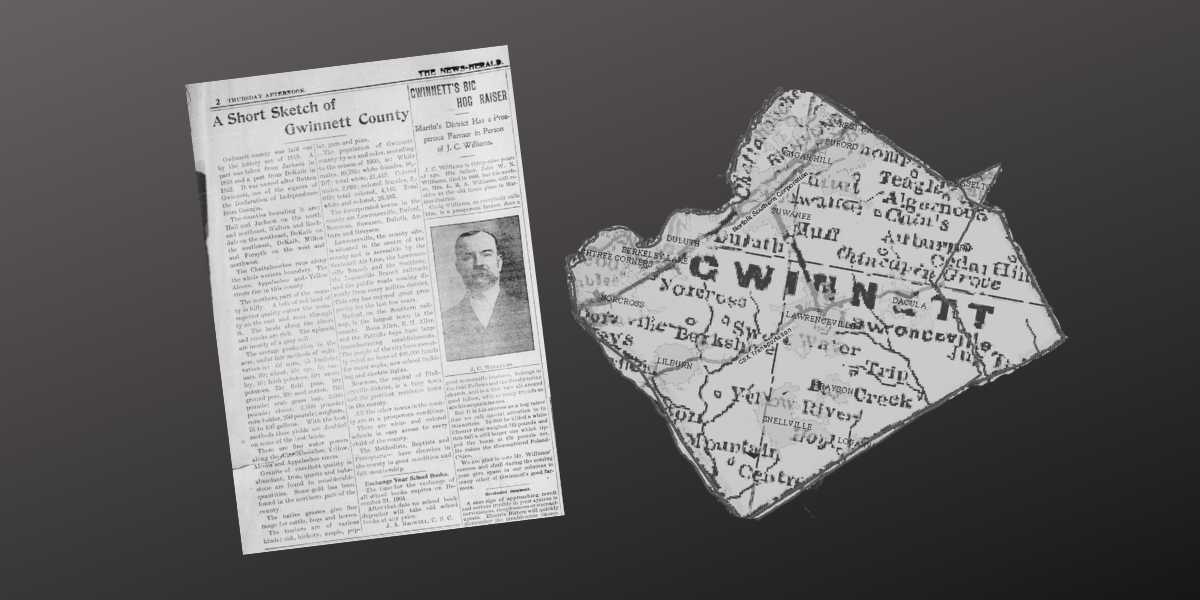With over 1 million residents in 2024, it is hard to imagine what Gwinnett County looked like 120 years ago. An article appeared in the Lawrenceville-based News-Herald newspaper in December 1904 titled “A Short Sketch of Gwinnett County” that gave a snapshot of what the county looked like at the time.

The article begins with a brief history of the county starting with its formation in 1818 with the Lottery Act where land was taken from Jackson County to create Gwinnett County. Four years later in 1822, Gwinnett County, named after Button Gwinnett, a signer of the Declaration of Independence, increased in size when part of Dekalb County was given to Gwinnett County.
In the article, the bordering counties were mentioned and the bordering counties are the ones of the modern day, with the exception of the county of Milton. Milton County was a county between 1857 and 1931. The Great Depression took its toll on the county’s finances forcing it to merge with Fulton County. The bordering counties were listed as “Hall and Jackson on the north and northeast, Walton and Rockdale on the southeast, DeKalb on the southwest, DeKalb, Milton and Forsyth on the west and northwest.”
The county topography was mentioned in ways that painted the picture of the county as fertile land with hills in the north. The county was blessed with the Chattahoochee River, forming the western border and the headwaters of three rivers began in Gwinnett County. Those three rivers are the Alcova, Appalachee and Yellow Rivers.
Crops that were being grown in Gwinnett County in 1904 that were mentioned in the article were corn, oats, wheat, rye, barley, Irish potatoes, sweet potatoes, field peas, ground peas, cotton, crabgrass hay, clover, corn fodder and sorghum. Cattle, hogs and horses were also being raised by farmers in the county.
An account of the most recent census at the time, the 1900 census was given and it is a totally different picture of the Gwinnett County of today. In 1900, the population of Gwinnett County was 25,585 residents with the white population being a 5:1 majority or roughly 83% of the total population. Only black and white races were mentioned as living in Gwinnett then. Today, the county is almost 40 times more populated than in 1900 and the racial makeup of the county is also vastly different. Gwinnett County in 2024 is a melting pot of races and cultures. The white population makes up just 33% of the total population today.
In 1904, only seven of the current-day 16 cities in Gwinnett existed at the time. Lawrenceville, Buford, Norcross, Suwanee, Duluth, Auburn and Grayson were the towns in the county then.
Buford was the largest town in Gwinnett County at the time. The railroad played a large role in the town’s success, as did the large manufacturing establishments of “Bona Allen, R.H. Allen and the Pattillo boys.” The article mentioned that Buford residents had recently voted on obtaining $20,000 in bonds to build a water works, a new school building and electric lights. While Buford remains the largest city in Gwinnett County in terms of acres within the city limits, it has slipped to No. 7 in terms of population according to 2023 statistics.
The predominant churches in the county were the Methodists, Baptists and Presbyterians. According to statistics from Stacker.com, the Catholic Church has taken the top spot of religions/churches in modern-day Gwinnett County. Southern Baptist Convention is No. 2, non-denominational Christian churches are No. 3, the United Methodist Church is in the fourth spot and the Wesleyan Church rounds out the top five.
It is evident from reading the 1904 article about Gwinnett County that a lot has changed in 120 years. What will Gwinnett County look like in another 120 years?

